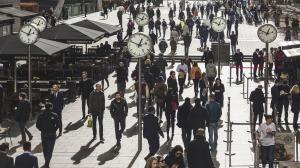
AM and PM Explained
How does the 12-hour clock system work? Is midnight 12 am or 12 pm?
Labor Day is also known as International Workers’ Day and May Day. It’s a public holiday in many countries worldwide. It usually occurs around May 1, but several countries observe it on other dates.

Labor Day is often used as a day to defend workers’ rights.
©iStockphoto.com/anouchka
Labor Day and May Day are two different holidays often observed and mixed on May 1:
Labor Day has deep roots in the 130 years of the labor movement and its efforts to improve workers’ conditions across the globe. Some argue that it is just as relevant today to highlight the challenges workers still encounter.
Labor Day is often a day for parades, demonstrations, and sometimes riots in major cities around the world. Paroles can include women’s rights, immigrant working conditions, and the erosion of workers’ conditions. The demonstrations usually happen on May 1 and are often referred to as May Day Protests.
With the growth of the Industrial Revolution came the demand for labor and trade unions. Around the 1850s, eight-hour movements across the world aimed to reduce the working day from ten to eight hours. At its first congress in 1886, the American Federation of Labour called for a general strike on May 1 to demand an eight-hour day, which culminated in what is known today as the Haymarket riot.
At the demonstration in Chicago, an unidentified bomb went off in the crowd, and the police opened fire. The altercation killed several police officers and civilians, and more than 60 police officers and 30 to 40 civilians were injured. In the aftermath, civilian sympathy landed with the police, and hundreds of labor leaders and sympathizers were rounded up; some were sentenced to death by hanging. Employers regained control of workers, and ten or more hour workdays became the norm again.
In 1889, the Second International, a European federation of socialist parties and trade unions, designated May 1 as International Workers’ Day. To this day, the first of May has become the symbol for workers’ rights worldwide.
In the US, the first Labor Day celebration was held in New York on September 5, 1882. Several states recognized the holiday in the years following, and Congress passed it as a federal holiday in 1894.
The holiday was set on the first Monday in September because it was considered a more politically neutral date instead of a date remembering the Haymarket riot. Still, May Day protests are common also in the US.
Labor Day is celebrated today with picnics, sports events, and parades. It has become the mark of the unofficial end of summer; after Labor day weekend, kids are back to school.
May 1 is also May Day, an ancient celebration of spring and the rebirth taking place in nature in the Northern Hemisphere. Many ancient customs associated with the day come from the old Roman festival of Floralia, where the people wore colorful clothes and were pelted with beans and flowers; symbols of fertility.
Also the ancient Greeks had traditions to welcome spring: Protomagia. It’s still celebrated on May 1 in Greece. Traditions include decorating doors with wreaths made from handpicked flowers to welcome the power of nature and upcoming summer into the home.
The Full Moon in May is named after flowers
In the United Kingdom, more than 2000-year-old May Day traditions are still alive in many towns and villages. The ancient Celts welcomed spring during Beltane by lighting bonfires or the ‘fire of Belt.’ Its fertility rituals have carried through to today, including crowning a May Queen and dancing around a Maypole.
The May Day Bank Holiday was instituted in the UK in 1978 for trade unionists to celebrate. It was, however, held on the first Monday in May to minimize the damage to businesses.
It seems like the Finns have perfected the amalgamation of pagan spring celebrations, Catholic traditions, and the celebration of students and workers in a holiday they call vappu. The name Vappu comes from the saint Walpurga. She was made a saint on May 1, 870 CE, and the night between April 30 to May 1 became Walpurgis Night.
May 1 is International Workers’ Day in Finland and the end of the school year for students. To keep things simple, the Finns have combined all of the traditions into a day to dress up in outrageous outfits, drink sima (fruity alcohol), and eat munkki (flavored doughnuts) and tippaleipä (funnel cakes). In other words, a day off to party.

How does the 12-hour clock system work? Is midnight 12 am or 12 pm?

Why do many countries set the clocks back and forth an hour twice a year?

Why are there 12 months? How long are they, and what do the month names mean?

Coordinated Universal Time (UTC) is the basis for civil time today. This 24-hour time standard is kept using highly precise atomic clocks combined with the Earth's rotation.